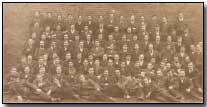Encyclopedia - U.K. Military Service Act
 With popular and mainstream
political opposition to mandatory military service, Britain was the sole
major European power not to have in place a policy of conscription when war
began in August 1914.
With popular and mainstream
political opposition to mandatory military service, Britain was the sole
major European power not to have in place a policy of conscription when war
began in August 1914.
Winston Churchill was an early advocate of introducing a form of conscription in 1914 but it wasn't until January 1916 that the British government introduced the first of a series of Military Service Acts which set out call-up regulations.
The introduction of the bill comprised a tacit acceptance on the part of the government that the previous approach to military service - the voluntary registration Derby Scheme - had failed to generate sufficient new recruits to stem the flow of losses on the various British battlefronts around the world.
In the face of opposition from such groups as the No-Conscription Fellowship - which actively encouraged men of service age to reject military service - the Act of January 1916 specified that men from the ages of 18 to 41 were liable to be called-up for service unless they were married (or widowed with children), or else served in one of a number of reserved professions (usually industrial but which also included clergymen).
Within four months a revised version of the Act was passed; this enabled the War Office in London to extend the service of time-expired servicemen and brought within the terms of the Act all men - regardless of marital status - from the ages of 18 to 41. The government also gained the right to re-examine men previously declared medically unfit for service.
In April 1917 the Act was modified once more. Home Service Territorials were to be examined with a view to drafting such men into service abroad. Men who had left military service on account of wounds or ill-health were to be re-examined to determine whether they were fit to resume service; and a revised list of reserved occupations was published.
With the demand for human war material apparently insatiable a fourth version of the Act was passed in January 1918. This enabled the government to quash all exemptions from military service on occupational grounds at its own discretion; and where exemptions from service had been withdrawn the standard two month grace period was abolished.
Three months later, in April 1918 - at the height of the great German Spring offensive on the Western Front - a fifth version of the Act was published. Its most notable provision extended age eligibility so that men aged from 17 to 51 could be called up. In addition the act was, for the first time, to be applied to men in Ireland, the Channel Islands and the Isle of Man (although the policy was never actually implemented in Ireland).
Between August 1914 and the introduction of the first Military Service Act as many as three million men volunteered for military service. From January 1916 until the close of the war a further 2.3 million men were formally conscripted into service.
Men who could demonstrate genuine conscientious objection to wartime participation - COs as they were termed - could feasibly escape front-line service, although most were expected to serve in non-combatant positions (which included such highly dangerous posts as front-line stretcher bearers).
Men who could not satisfactorily demonstrate a conscientious objection, and who persisted in their refusal to serve (the 'absolutists'), suffered financial penalties, with many men also sent to prison (click here to read more about conscientious objectors).
The Austro-Hungarian declaration of war was the first ever delivered by telegram.
- Did you know?
